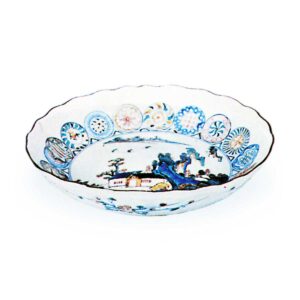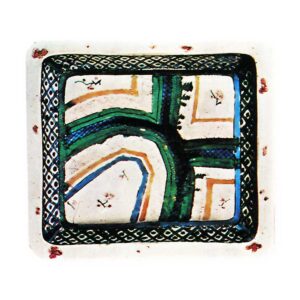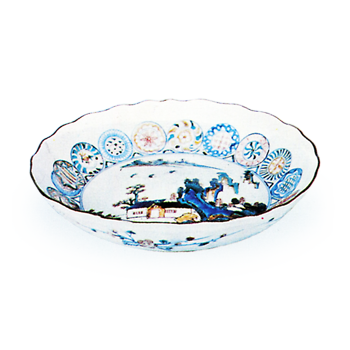

Porcelain from Kaga Province (Ishikawa Prefecture). It is one of the first porcelains in Japan, and together with Kakiemon and Ninsei, is considered one of the three origins of painted ceramics in Japan, and is particularly famous for the masculine strength of its style. There are several theories regarding the origin of this pottery, including the Kan’ei black earthenware period (1624-44), the Shoho and Keian periods (1644-52), the second year of the Jouou era (1653), and the first year of the Meireki era (1655). When Toshiharu was transferred to Daishojiji, Enuma County (Kaga City), he had his vassals Saijiro Goto, Sadatsugu Goto, Gonzaemon Tamura, and others try to make pottery in various places within the domain, and around Shoho (1644-8) they discovered good porcelain clay in Kutani Village (Yamanaka-cho, Enuma-gun). Just when Toshiharu had had enough of the Sukezaka ware of the same area, he sent Sadatsugu’s son Tadakiyo to Hizen Arita during the Manji era (1658-161). Tadakiyo was very diligent in his efforts, but the secret of the pottery family remained firm. He happened to meet an exiled potter from the Ming Dynasty in Nagasaki, who accompanied him back to Japan, and it is said that he started manufacturing porcelain in the former Kutani Village in the early Kanbun period (1661-173).
In February 1674 (Enpo 2), Kibei Fujita and others produced plates and bowls in Hayashi Village, Enuma County (Hayashi Town, Komatsu City). Although this was a private kiln, the products were not much different from those produced in the domain kilns of Kutani Village, and are still referred to today as Ko-Kutani. The Ko-Kutani tradition continued for about 30 years under the protection of the Atsuku Clan, but was completely discontinued in the early Genroku period (1688-1704) due to the suspicion of the shogunate and the protests of the Nabeshima Clan. The name “Ko-Kutani” originated from the Yoshidaya kiln, which opened during the Bunsei period (1818-30) and was called “Ko-Kutani” to distinguish it from the old Kutani ware produced in this area. There are various theories as to the origin of the technique and the identity of its founder, Saijiro Goto Tadakiyo, and it is said that the technique was learned in Arita. Recently, some have suggested that it was made in the early Imari period, part of the Ko-Kutani period, since fragments of Ai-Kutani style porcelain and pieces with honorable Taimei inscriptions have been excavated from the Arita kiln site.
The largest number of dishes, bowls, kudashi bowls, tokuri (Japanese tea utensils), incense burners, etc. are molds. Tea sets and sake cups are rare. The most characteristic feature of this type of pottery is its painting, which is outstanding in design and composition, and the brushwork is strong and free, and at the same time, elegant and dignified. The birds, animals, plants, trees, landscapes, and houses depicted in these paintings are not limited by comparisons of large and small, and the colors are bold and often exceed the reality, instead showing the beauty of harmony. The following is an explanation of the style in chronological order: (1) Sukezaka Ko-kutani: Ko-kutani was fired in Sukezaka, Kaga City, before the Ko-kutani style was established. Like Ko-kutani, it was painted within the Daishojiji Castle. The main type of pottery is Seto-style brown-glazed pottery or Bizen-style stoneware matcha utensils. The base was then covered with Nanjing-style persimmon glaze and a white ground, and patterns were added in colors, red, silver, and other styles. This is what is called sukusaka ware, but since fragments of this type have been excavated from the Arita kiln site, some have suggested that this is early Imari ware. (2) Shozui-style overglaze enamels: This type of overglaze enamels is based on the Ko-Kutani Shozui-type underglaze enamels. The round patterns are particularly abundant, and are generally from the early Ko-Kutani period. (3) Ming-style five-color Ko-kutani, a representative example of the best of Ko-kutani. The base is refined and the style of the painting is also noble, and the painting of Chinese-style flowers, birds, landscapes, figures, and patterns is mature. Black and red were used for the bone painting, and five colors (green, yellow, purple, dark blue, and red) were used for the darker colors. This type of work is called kokutani for “dedication. (4) Koya Koya painted in five-color Kano style, but with a marked change in style to the Kano style. The work called “Morikage Naoe” is from this period. The porcelain quality is inferior, the underglaze blue is dull, and many of them have no rusted edges. (v) Sotatsu-style Ko-Kutani: This style was influenced by Tawaraya Sotatsu. The Kano style and the Kano style are also used in this type of work.
There are few rim-red and underglaze blue, and few pieces use all of the five colors of the Five Colors technique. The base has a slightly whitish tinge and is more elegant than the Kano style. (VI) Three-color Kutani style: The dark blue has disappeared and red is no longer used, and only black is used for painting with purple, yellow, and green.
Some of this type of fine work has a very thin base, with an increased degree of transparency, and some coaches are decorated with a small amount of gold and silver. (7) Nisai Ko-Kutani: A type of Kutani in which only green and yellow are used on a black cat without using purple. The firing temperature of this type is low, and the base is thick and almost pottery-like, with some fine cracks. The entire surface is generally painted with thick brush strokes of flowers, birds, fish, and animals, often in two colors, and is a model of the later Yoshidaya style. The technique of using transparent colors on black lines is called Persian-te Ko-kutani, and is also called simply Aote Ko-kutani. (8) Akae Ko-kutani (see separate entry) (9) Yoride Ko-kutani (see separate entry) (+)
Some late Ko-kutani with a milky-white base, similar to the texture of Kakiemon. The design is generally painted in red, gold, and silver, with occasional dots of dark blue, purple, and green. The dark blue is also cloudy. The dark blue is muddy, the purple is dull, and the green is also thin and differs from the coloring of the Meisho style, but only the red is unique to Ko-kutani, and the design is also in the Ko-kutani style. (11) Kogutani lapis lazuli (lapis lazuli kotsuya): Both the lipstick and the blue color are similar to those of Chinese Qing dynasty porcelain, but the style of the painting is Kogutani. The painting style is Ko-Kutani, using only gold, silver, and red without any coloring. The red color is slightly fleshy and glossy, and differs from the red of five-color Ko-kutani porcelain. The red of Ko-kutani is different from that of Gosai Ko-kutani. (12) Celadon glaze and white porcelain are rare in Ko-kutani. (12) Celadon glazes are rare in Ko-kutani. Most of them are painted with celadon and white porcelain glazes, or with lapis lazuli glazes instead of celadon glazes.
The color is pale green and of low quality, and although there are some examples with gold and silver paintings on the celadon glaze, they do not have any other colors. (13) Ko-kutani with underglaze blue and gold belongs to the late Ko-kutani period. The pattern is clearly expressed in indigo on a very pure white fine-quality base, and then the pattern is elaborately applied with gold, silver, and red over the pattern. (14) Ai-koya kutani (see separate entry). In addition to these types, there is another type called nisei kutani or Daishoji nisei. This type was produced at the Sukezaka Kiln, and shows the style of the Nikiyo style in the green, dark blue, yellow, and red colors of the painting, as well as in the open flakes and rusty glaze. There are also vessels with color schemes of Western-style patterns. According to legend, Ko-Kutani ware was fired in Kutani kilns using only a white base and underglaze blue, celadon, or lapis lazuli glaze, and then brought to the Daishojiji castle for color painting.
The most common seal is the character “fuku” (福), which is broken in various ways similar to slang in the double square, followed by a variant of the character “green” (緑) or characters that continue to read similar to Muromachi period itoin (糸印), some of which are simply written “Taimei,” “Manyoku,” or “Taimei Kasei Nen. In addition, many of the underglaze blue and celadon wares have the character “Kotobuki” in a double circle, with “Kotobuki” and “Fuku” superimposed, or “Tenka Taiping” written on the top. Many of them are unmarked.
Koya imitations: Since the Wakasugi kiln, there have been many imitations in Komatsu, Daishoji, Yamashiro, and other areas. The glaze is not deep, the colors are pale, the red has a slightly yellowish tinge, and the design has a slight Imari feel to it. The reproductions made at the Kutani Pottery Company in Yamashiro around 1887 (Meiji 20) skillfully approached the photographic works in terms of the base, base construction, rusting around the rim, painting, shape, design, and seal, but the colors of the underglaze blue were too pale and too beautiful. The Kutani kiln, which was restored by Inoue Ryuhei of Daishoji Temple around the end of the Meiji period, was made by refining the original clay from the old site, so it is difficult to be sure of the authenticity of the kiln. (History of Kutani Ceramics)



